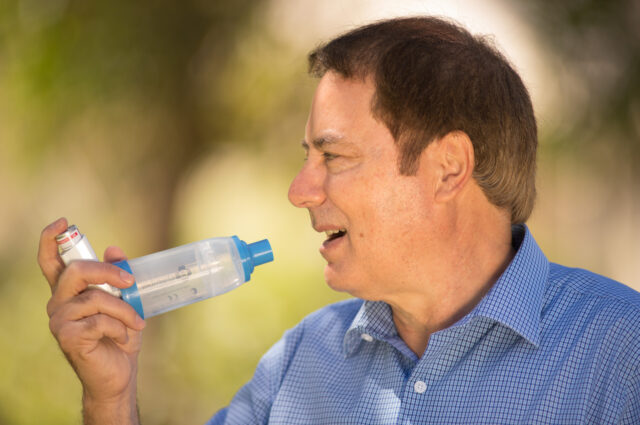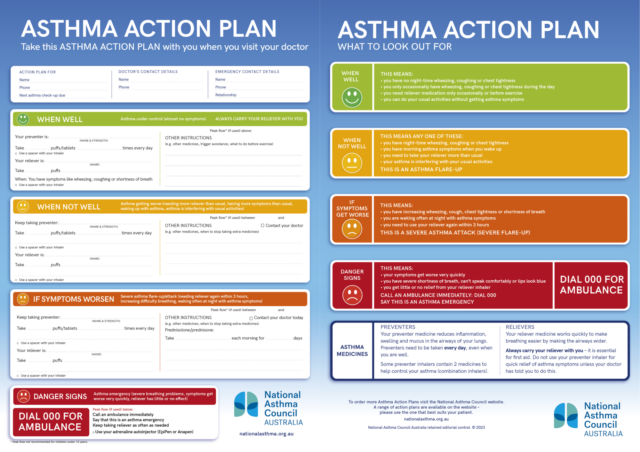Australian Asthma Handbook
The National Guidelines for Health Professionals
In regions with seasonal high concentrations of airborne grass pollen, thunderstorms in spring or early summer can trigger asthma symptoms in people with grass pollen allergy, even if they have not had asthma before.
Thunderstorms can trigger severe and even life-threatening exacerbations in people with asthma.
People with asthma who are allergic to ryegrass pollen and are not using ICS are at highest risk of life-threatening exacerbations.
People with asthma and known grass pollen allergy or springtime allergic rhinitis should receive ICS treatment and advice on avoidance during pollen season: on days when there is a high concentration of ryegrass pollen in the air and thunderstorms are predicted, they should avoid exposure outdoor air, especially gusty winds before the rain.
Certain types of thunderstorms in spring or early summer in regions with high grass pollen concentrations in the air can trigger life-threatening bronchoconstriction in people sensitised to ryegrass.[Thien 2025, Price 2021, Girgis 2000, Marks 2001, D’Amato 2016]
These weather conditions are thought to cause airborne pollen grains to release ultrafine starch particles that are small enough to reach small airways when inhaled.[Thien 2025]
Epidemic thunderstorm asthma events are uncommon, but when they occur they can overwhelm ambulance services and emergency departments and result in multiple deaths.[Thien 2020, Thien 2025] The seven Melbourne thunderstorm asthma events reported between 1984 and 2016 all occurred in November during peak ryegrass pollination, while several events in New South Wales have occurred in October.[Davies 2017]
People with allergic rhinitis and allergy to ryegrass pollen (i.e. most people with springtime allergic rhinitis symptoms) are at risk of thunderstorm asthma if they live in, or are travelling to, a region with seasonal high grass pollen levels. This includes people with no previous asthma, undiagnosed asthma, or known asthma.[Price 2021, Girgis 2000, Thien 2025]
Pre-existing sputum eosinophilia is associated with severe exacerbations due to thunderstorm asthma.[Thien 2025]
During the Melbourne 2016 thunderstorm asthma epidemic, the worst outcomes (life-threatening asthma and death) were in people with poorly controlled asthma.[Thien 2017, Thien 2020] Maintenance ICS treatment was significantly protective against thunderstorm asthma in a study conducted in a rural NSW emergency department.[Girgis 2000]
Lack of inhaled corticosteroid preventer treatment was identified as a risk factor for severe exacerbations during an epidemic event, while ICS use appeared to be protective.[Thien 2020] Patients with grass pollen allergy who self-manage their asthma using non-prescription salbutamol are therefore at highest risk of severe exacerbations during thunderstorms.
Adults may be at higher risk of thunderstorm asthma than children, based on the lower proportion of children in case reports.[Kevat 2020] During the 2016 Melbourne epidemic thunderstorm asthma event the proportion of children admitted to ICU was much lower than adults.[Thien 2019] Adults aged 20–59 years comprised 57% of the emergency department admissions for asthma, compared with 21% average for the same 30-hour period in the previous 3 years.[Thien 2019] However, severe exacerbations due to thunderstorms have been reported in children.
Risk factors in children appear similar to those in adults. Among children admitted to hospital with asthma symptoms during a 2018 thunderstorm asthma epidemic in China, only 25% had a confirmed previous diagnosis of asthma, but 67% had a history of allergic rhinitis.[Xu 2021]
All patients at risk of thunderstorm asthma should:
There is insufficient clinical trial evidence to determine whether intranasal corticosteroids help protect against thunderstorm asthma. Intranasal corticosteroids reduce symptoms of allergic rhinitis and limited indirect evidence suggests they may protect against asthma exacerbations in people not taking inhaled corticosteroids,[Lohia 2013] but their efficacy in protection against thunderstorm asthma is unknown.
Specific allergen immunotherapy might be effective in protecting against thunderstorm asthma,[Price 2021] but this has not been evaluated in randomised clinical trials. Data from a small Australian open-label study suggest that short-term treatment with five-grass sublingual immunotherapy may have been protective in individuals.[O’Hehir 2018]
People at risk should avoid exposure to outdoor air just before and during a thunderstorm in springtime and early summer, especially during wind gusts just before the rain front hits. Current advice is to get indoors with windows closed and turn off air conditioners that bring outdoor air inside (e.g., evaporative systems), or shut car windows and recirculate the air. These measures may not completely prevent exposure.
D’Amato G, Vitale C, D’Amato M, et al. Thunderstorm-related asthma: what happens and why. Clin Exp Allergy 2016; 46: 390-6.
Davies J, Erbas B, Simunovic M, et al. Literature review on thunderstorm asthma and its implications for public health advice: Final Report. Brisbane: Queensland University of Technology; 2017.
Girgis ST, Marks GB, Downs SH, et al. Thunderstorm-associated asthma in an inland town in south-eastern Australia. Who is at risk? Eur Respir J 2000; 16: 3-8.
Kevat A. Thunderstorm asthma: looking back and looking forward. J Asthma Allergy 2020; 13: 293-299.
Lohia S, Schlosser RJ, Soler ZM. Impact of intranasal corticosteroids on asthma outcomes in allergic rhinitis: a meta-analysis. Allergy 2013; 68: 569-79.
Marks GB, Colquhoun JR, Girgis ST, et al. Thunderstorm outflows preceding epidemics of asthma during spring and summer. Thorax 2001; 56: 468-71.
O’Hehir RE, Varese NP, Deckert K, et al. Epidemic thunderstorm asthma protection with five-grass pollen tablet sublingual immunotherapy: a clinical trial. Am J Respir Crit Care Med 2018; 198: 126-8.
Price D, Hughes KM, Thien F, et al. Epidemic thunderstorm asthma: lessons learned from the storm down-under. J Allergy Clin Immunol Pract 2021; 9: 1510-1515.
Thien F, Davies JM, Hew M, et al. Thunderstorm asthma: an overview of mechanisms and management strategies. Expert Rev Clin Immunol 2020; 16: 1005-1017.
Thien F, Davies JM, Douglass JA, et al. Thunderstorm asthma: current perspectives and emerging trends. J Allergy Clin Immunol Pract 2025; 13: 1273-1280.
Thien F, Beggs PJ, Csutoros D, et al. The Melbourne epidemic thunderstorm asthma event 2016: an investigation of environmental triggers, effect on health services, and patient risk factors. Lancet Planet Health 2018; 2: e255-e63.
Xu YY, Xue T, Li HR, et al. Retrospective analysis of epidemic thunderstorm asthma in children in Yulin, northwest China. Pediatr Res 2021; 89: 958-961.
National Asthma Council Australia’s Thunderstorm asthma information paper
ASCIA’s Pollen calendar
Victorian Government Department of Health Epidemic thunderstorm asthma risk forecast

Principles of management
Goals and principles of asthma management in adults and adolescents.

Medication management
How to choose optimal starting treatment for patients 12 years and over.

Medication management
How to step up or step down asthma treatment for an individual patient to maintain control and minimise side-effects.

Principles of management
Goals and principles of asthma management in primary school-aged children.

Medication management
How to choose optimal starting treatment for children aged 6–11 years.

Medication management
How to step up or step down asthma treatment for a child aged 6–11 years, to maintain symptom control, prevent…